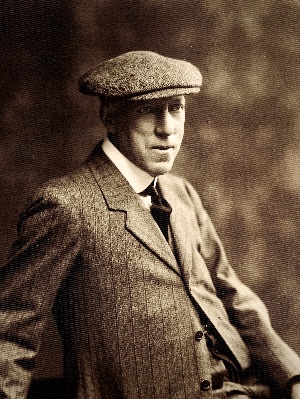Siddall, John Henry
Dancer
Collection date: Jan 1913
Area: Yorkshire
John Henry (‘Harry’) Siddall of Handsworth longsword, Sheffield (1865-1934): The Siddall family were the mainstay of the Handsworth side for decades commencing c1890. Harry Siddall was the captain of the side when Sharp first made contact in January 1913. He was aged 47 by then and his three younger brothers were also in the side – William (b1867), Joe (Joseph b1869) and Walter (b1871). He continued as captain and received a silver badge from Sharp when the Handsworth men danced at the EFDS Easter School held at York in 1920. A few years later his son Billy Siddall took over the captaincy.
There are records of a sword dance team at Woodhouse, the village adjacent to Handsworth, from the 1860s, as started by Joseph Rhodes from Dronfield, Derbyshire (7 miles to the SW). Joseph wasn’t really an ‘outsider’, because his father, Joseph Snr was originally from Woodhouse (b1801). The whole Rhodes family was back in Woodhouse by the 1841 census and Joseph Snr, a master tailor, remained there till his death in 1872. Joseph Jr, who started the dancing, was born in 1837 and was already a coal miner at age 13 (1851 census). It’s conceivable that the splendid hussar-style costumes worn by the dancers were designed and made by the master tailor Joseph Rhodes Snr himself. Joseph Jr was living at Sheffield Rd in Woodhouse in the 1911 census, aged 72 with his wife Clara but Sharp did not interview him.
This ‘early’ Woodhouse team seems to have folded around 1887 but one of its dancers Alfred Wheeler (1852-1932) had taught some men at Handsworth and they had danced regularly every Christmas time since c1890. Wheeler was a coal miner (probably at the Orgreave pit, like other Handsworth men) and was consulted about Sharp’s proposed visit – see letters by go-between Matthias Parkin, a Woodhouse gardener https://www.vwml.org/search?q=Matthias%20Parkin%20Sharp&is=1
Sharp watched the men dance on Tues 14 January, talked with Harry Siddall and took careful notes (transcribed to Folk Dance Notes 3/1-7). He thought the dance was ‘splendid’ and was pleased when a month later he was sent 4 tunes (FT2816) by Ernest Shaw. The latter was probably not the musician for the troupe (the name of Tom Gray is usually quoted for that role). Possibly Shaw, who was aged 35, a yardman from Darnall, was a member of the local Prize Band and was asked to write out the notation. Sharp thanked him in the Preface of his Sword Dance Book 3, when it came out later that year. Sharp promised to return to Handsworth in April to tidy up a few points and to take Siddall’s photograph. He used the Handsworth dance in his lectures and demonstrations, and was in discussions with the Neptune film company of Elstree to record a silent movie of the dance in June 1914 – this film was made but seems to have been lost.
John Henry ‘Harry’ Siddall was born in April qr 1865 (ref 9c 385), eldest of 5 children of John Siddall, coal miner and his wife Frances (Fanny). His mother was from Gainsborough in Lincs and her maiden name was Adby. His father John unfortunately died in 1876 and all 4 sons went out to work as coal miners as soon as they were able. In the 1881 census Fanny was working as a charwoman and the family were living next door to the New Crown Inn in Handsworth. That inn became the practice base for the ‘new’ dance side that sprang to life soon afterwards.
Harry Siddall married Charlotte Broadbent in January qr 1892 (ref 9c 457) and they had 9 children, one of whom Billy (b2/5/1902) would take over as dance captain (as described). Charlotte died in 1911, aged only 44, and Harry continued as a coal miner (hewer) with his children around him. He lived at 6 Clough Rd (also known as Medlock Rd), where several of his fellow dancers also lived. Harry Siddall died in the January qr 1934 (9c 764) aged 69.
The Handsworth team was somewhat disrupted by WW2 but reformed strongly and has now become a mixed team. See their website http://www.handsworthsworddancers.org.uk as well as various Youtubes. Their history was well documented by Geoff Lester in Folklore Journal vol99 no.1 (1988) pp110-123. A most useful doctoral ethesis is available online ‘Continuity, Conflict and Change’ (2 vols) by Cynthia Marie Sughrue (University of Sheffield 1992) http://etheses.whiterose.ac.uk/3425/2/247720_vol1.pdf pp82-103 and pp138-148 in particular.

